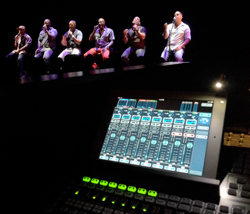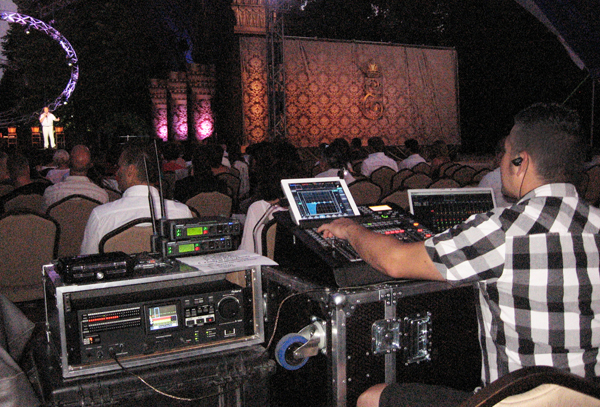
He uses the M-200i console’s onboard EQ, crossover and compression exclusively.
“It’s usually six guys and six mics – eight when Khristian, David or Alvin play piano – and I split it two ways; one layer for front of house, and a second layer, split internally to a second layer of faders, for monitors. That allows me to have a separate EQ for the house and monitors. Then I’ll split out the bass and vocal drums and send that to the subs on an aux to create the low end.
“I use all four FX units on the M-200i and the graphic EQs, which I insert on the mains, and parametric EQs on every channel and every output,” he continues. “For the subs, no matter what house we’re in, I create my own crossover with a low-pass filter on all the auxes that go to the subs. Then I’ll put a high-pass filter on the mains and create my own crossover, because, for an a cappella band, I want the crossover a little higher than I would for a band to reinforce the low end power of the bass vocal.”
Dialing It In
He’s always mixed the group’s monitors from FOH, with the M-200i simplifying that process significantly: “I set up each gig in about half an hour, and our sound check now takes about 10 minutes. We start with the IEM mix so the band can get comfortable with the stage and then I dial in the house. After that all they need to do is decide how much of the downstage ambient audience mics (Rode NT5 cardioid condensers placed left and right) they want in their ears.”
Via the Roland R-1000, he’s recording each show (18 live tracks in .wav format) as well as doing virtual sound checks that have made things even more efficient. “I just play back the previous night’s show directly into the M-200i multi-channel and bring up each individual mic as if the guys were there singing, so I can dial in the house mix before they even arrive.”
So the compact setup simplifies the day-to-day workflow for both he and the group, while Huerta’s experience as a singer in a cappella groups such as Urban Method and his work as a recording engineer and owner/operator of Sonic Audio (a studio in Denver that caters specifically to a cappella groups) also helps mightily in capturing and presenting the power of Take 6 live.
“Knowing what it’s like on stage in an a cappella setting, and understanding the power of the human voice and that the low end is what makes audiences ‘fly out of their seats’ is something I learned performing,” he concludes. “With Take 6, there are no instruments between the human voice and you. What they perform is straight out of their souls, their hearts, and their bodies, so audiences connect to it in a very personal way.”
Kevin McPherson is a feature contributor for ProSoundWeb and Live Sound International.

